UNIT 2:ENVIRONMENTAL IMPACT ASSESSMENT (EIA)
Key Unit Competence: To be able to prepare EIA report as a tool for
preventing negative effect of business activities on the environment.Introductory activity
Case study: Rwanda’s government through Rwanda Environment
Management Authority (REMA) and environmental impact assessment report (EIA)
guidelines expects entrepreneurs to be cautious and careful with goods produced,
the technology used, the materials used for the production
and their probable impact on human health and the environment.
If the product/ project does not meet the requirements of the general
expected standards, then it is not permitted for further productionand the owner will have to change the technology and the structure of the product.
Rwanda has tremendously grown in areas of urbanization and the infrastructure,
economic activities for example furniture workshops (timber), charcoal stores,
bottled water production etc. If not well addressed are bound to impact
negatively on the environmental attributes of the project areas
and its surroundings like water pollution, air, land pollution,
deforestation etc. Kigali being the capital city of the country,
it continues to have the most economic activities and population
with such economic situation, the economy and the environment
are bound to be affected negatively and positively thus entrepreneurs
intending to start any project have to prepare appropriate Environmental
Impact Assessment reports showing most sustainable and cost effective
way of mitigating any negative impact that may arise as a result of the
implementation of the proposed project.Questions:
Referring to the above case study, answer the following questions.
a. Using your previous knowledge of entrepreneurship and as a student
who intends to start a small brick laying project in the holidays summarize
the positive and negative effects your project mayhave on the environment and surrounding?
b. What strategies would you propose to the entrepreneursin Kigali to mitigate the likely challenges as a result of the projects started?
c. Identify the importance of Environmental ImpactAssessment report for business idea you intend to start in your community.
2.1 Definition of Environment and Effects of business activities on the environment
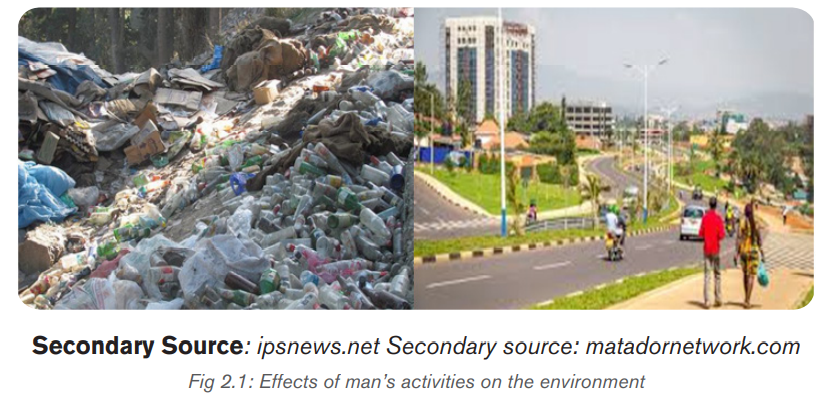
Activity 2.1
Consider this: Many buildings are built from materials
that do not come from renewable sources. Office buildings have
a huge appetite for electricity to power lighting, air conditioning,
computers, printers, and photocopiers. Equipment may be left on 24 hours a day,
seven days a week-even when no one is working.
Offices consume vast amounts of paper. Even with more offices recycling paper,a large amount of paper waste still goes to landfill sites or incinerators.
In addition to paper, offices produce a lot of other waste, including equipment
(especially computers), because companies regularly upgrade their equipment
to stay competitive. Electronics such as photocopiers and computers
can end up in landfills, where they do not break down and,
even worse, can leach harmful chemicals into the ground and water.
Rush-hour traffic jams in towns and cities are full of people trying to
get to work-wasting time and polluting the atmosphere.Questions
1. In your own words what is the environment?
2. What activities mentioned in the case study that affect the environment?
3. Identify the would-be positive effects of the above activities on the environment?2.1.1 Definition of Environment
The term Environment is derived from a Latin word “Environia”
which means to surround. It refers to both abiotic (physical or non-living)
and biotic (living) environment. The word environment means surroundings,
in which organisms live. Therefore; environment is the sum total of conditions
that surrounds us at a given point of time and space. It is comprised
of the interacting systems of physical, biological and cultural
elements which are interlinked both individually and collectively.
Environment is the total sum of conditions in which an organism
has to survive or maintain its life process. It influences the growthand development of living forms.
Business environment is the total sum of all external and internal
factors that influence a business. Business environment is the combinationof internal and external factors that influence a company’s operating situation.
The business environment can include factors such as:
clients and suppliers; its competitors and owners; improvementsin technology; laws and government activities; market, social and economic trends.
i) According to P. Gisbert “Environment is anything immediately
surrounding an object and exerting a direct influence on it.”ii) According to E. J. Ross “Environment is an external force which influences us.”
2.1.2 Effects of business activities on the environment
Positive effects of business activities on the environment include:
• Saves on cutting down forests for fuel.
• Reduction on carbon emissions which depletes the ozone layer.
• Reduction on soil fertility loss and leaching of minerals.
• Reduces water loss from the soil.
• More forest cover which improves the air we breathe in.
• Reduction on desertification and leads to more rain.
• Makes environment appealing and more beautiful.
• Increased vegetation cover which improves the quality of air.
• Improved drinking water quality, household sewage connection,
and improved hygiene practices.
• Results into taxes which the government earns as revenue to set up
social amenities such as schools, hospitals, roads and
provide security to the country.
• Results into production of goods that satisfy people’s needs
thereby improving the society’s well-being.
• Creation of employment opportunities for the people
thereby improving their standards of living.
• Corporate social responsibility activities such as sponsoring sports activities,
planting of trees, building of schools and hospitals which help the community.
• Business activities promote infrastructural development
in the society such as road construction, schools, and houses for peoplethus contributing to the development of the society.
Business activities that positively affect the environment include:
• Reuse, reduce, and recycle activities that reduce wastage and other activities
that would affect the environment negatively.
• Afforestation: This involves planting trees whichhelps regenerate the environment.
• Proper Waste management: This is the collection,
transportation and disposal of garbage, sewage and other waste products.
• Social responsibility: “Umuganda” literally translated as
‘coming together with a common purpose to achieve an outcome’.
Most business are involved in communal/collective work that protect the environment.
• Horticulture and floriculture: This involves planting of crops especially
flowers which beautify the environment.
• Building of terraces in hilly or mountainous terrain to decrease both erosionand surface runoff thereby protecting the environment.
• Replacing non-decomposable materials with decomposable ones such as
polythene bags with paper bags. Paper bags can easily decomposein soil there by protecting the environment.

Negative effects of business activities on the environment:
These include:
• Soil degradation: This refers to the destruction of soil fertility,
soil nutrients composition (organic and inorganic)
resulting from overgrazing, over cultivation, deforestation,
mining and quarrying and contamination from disposal
of harmful waste products (industrial wasted oils and chemicals).
• Industrialization: Although industrialization is important
for the economic growth and development of a society,
it is also harmful to the environment. Amongst other things,
industrial processes cause climate change, water, air and soil pollution;health issues, extinction of species, and so on.
• Deforestation: Some business use trees in their operations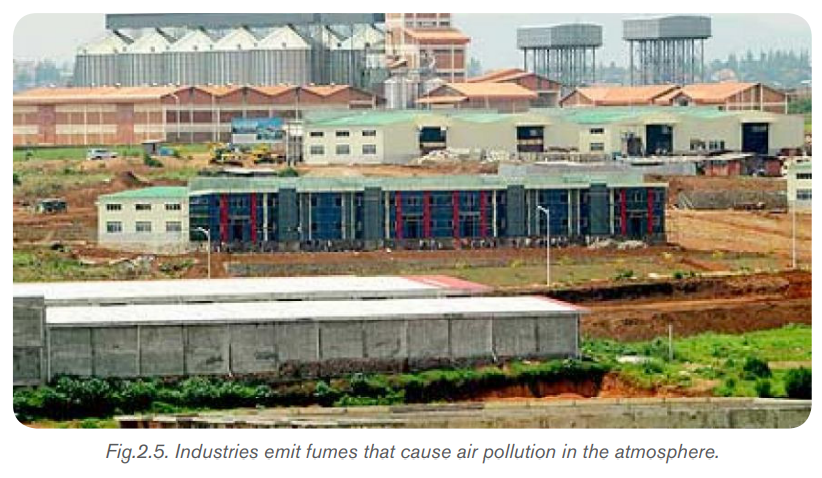
for production of goods and services, e.g. carpentry workshops,
construction, businesses and household’s clear large tractsof forests to make farms, roads and railways.
• Heating and air conditioning systems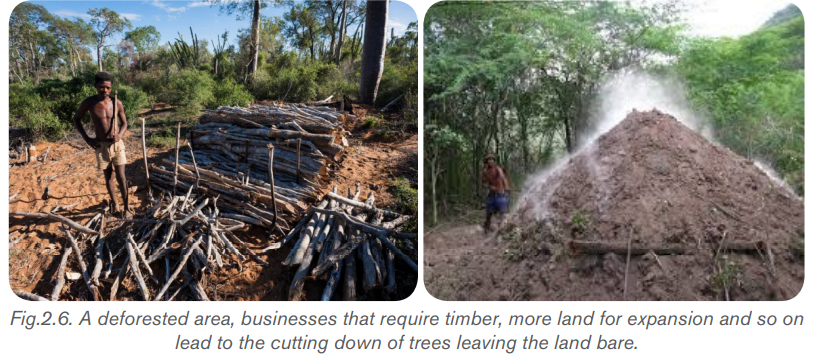
pump greenhouse gas emissions from officesinto the atmosphere and use up vast amounts of electricity.
• Poor waste disposal: Offices produce a lot of waste
including equipment which end up in landfills,
where they don’t breakdown and, even worse,can leach harmful chemicals into the growth and water.
• Depletion of resources: Businesses use a lot of natural resources
in their operations. For example, manufacturing businesses
deplete minerals, lumbering depletes forest resources,
fishing depletes/reduces the water resources and miningand quarrying destroys and degrades land.
• Pollution (air, water, land): Businesses emits a lot of carbon dioxide,
smoke, ozone depleting gases, dust Sulphur-dioxide andso on which is dangerous for animal and plant respiration.
• Displacement of people: The establishment of businesses
displaces people which affects the balancing of the ecosystem
causing over population in given places and henceaffecting the natural environment.
• Rush-hour traffic jams: In towns and cities are fullof people trying to get to work-wasting time and polluting the atmosphere.
• Vibration: This is the result of movement and running
of heavy industrial machines. These vibrations produced greatlyweaken buildings leading to collapse of such affected building.
Business activities that negatively affect the environment
The business owners can carry out activities
that affect the environment negatively.
How are the business activities eco-friendly
when it comes to the environment and its natural resources?
You may be surprised by some specific examples of waysthe working world damages the environment:
Business activities that negatively affect the environment include:
• Charcoal burning: This is done to get charcoal for sale. This business activity
leads to deforestation (the cutting down of trees). The trees are burnt and,in this process, fumes are emitted in the atmosphere leading to air pollution.
• Construction: Businesses clear land to construct business buildings.In this process, they cut down trees and at the same time degrade the soil.
• Swamp reclamation: This is the clearing of swamps for various purposes
such as settlement, farming and so on. Swamp reclamation leadsto the destruction of the ecological cycle and wildlife habitats.
• Industrialization: This activity leads to the emission of poisonous
fumes into the atmosphere (air pollution). It also leads to land
pollution when waste products of business activities are deposited on land.Water pollution can also occur.
• Agriculture: This is the growing of crops and rearing of animals.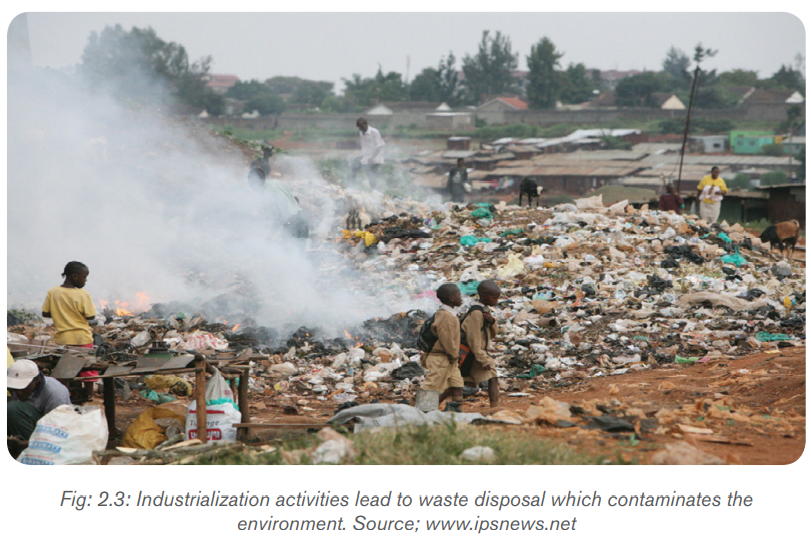
Poor methods of farming such as overgrazing and over croppinglead to soil degradation.
• Bricklaying: This is the modeling of bricks fromsoil and clay for sale. This activity leads to soil degradation.
• Fishing: This is the extraction of animals from water bodies
for sale and consumption. Bad fishing methods lead to the fishing
of young fish and extinction of certain fish species from water bodies.
• Mining: This is the extraction of minerals from the soil.Mining leads soil degradation, soil erosion and displacement of people.
• Lumbering: This is the cutting of trees for commercial purposes.As trees are cut down, the soil is left bare and this can lead to soil erosion and reduced rain.
• Packaging: Most businesses have packaging materials for their goods
such as plastic bottles, polythene bags, glasses and so on.
These packaging products are non-biodegradable and are harmful to the soil.
Application activity 2.1
Read the case study below and answer questions that follow.
But it is it is just a bottle of water
On the way to school, Sally and her mother picked up consumables
for her to use at school. Sally’s mother insisted on getting bottled water
for her daughter because of her strong belief that bottled water
was safer and cleaner than tap water. Back at the dormitory,
however, Sally’s new roommate, Jane, argued against this with
facts she had learned in class.
“Did you know that while tap water is frequently tested to maintain
public health and safety, bottled water has no guidelines for testing?
The Rwanda Standards Board can’t regulate all the water that is bottledand sold within the country, which accounts for most of bottled water.
” Sally was taken back by her new room-mate’s comments on thefirst day that they met.
“Ummmmh, ok, but it can’t be that bad,” she said.
Sally’s mother, on the other hand, admired Jane’s enthusiasmand passion for the environment, and her knowledge of bottled water.
“So, what you’re saying is that you want to pay a lot more for untested
sealed water in bottles that are horrible for the environment,
especially since people don’t recycle?” said Jane.
“Water bottles are convenient ... anyway, I recycle ... sometimes,” said Sally.
Jane was shocked to hear that her new roommate didn’t recycle often.
What kind of person was she? “Do you know what happens
to the recycled water bottles?!” she asked.
Feeling momentarily brilliant, Sally said,”
They go into landfills, of course.”
“Yes, landfills that are filling quickly,” snapped Jane.
“We don’t have room for water bottles that could be recycled.
When water bottles are thrown in trash, not only do they fill landfills,
but they also increase air pollution and destroy our ozone layer.
When they are burned with the regular trash,
toxic fumes are emitted that are harmful to our health,
and these include greenhouse gasses that are harmful
to the environment.”
“Okay, okay, you made your point; I’ll recycle my water
bottles all the time,” said Sally.
“But you still won’t stop drinking bottled water!
Do you know where the water comes from?
A lot of companies get their water from aquifers,
many of which are running low. Water bottle companies
do bulk water exports, extracting groundwater at unsustainable rates.
And did you know that once an aquifer is emptied or polluted,
they are almost impossible to restore? Soon we will have some major water shortages.
” Sally was frustrated, already arguing with her roommate,
but she realized that Jane made a good point,
and was impressed with her knowledge.
But she still wondered why we didn’t hear about these effectsif they were so horrible and what could they do about it anyway.
Two weeks later Sally’s mother was in the super market back
in her hometown and reached for a case of bottled water.
She hesitated and thought “should I really be buying this waterif it is so bad for the environment?”
Questions
a. Should Sally’s mother buy the bottled water?2.2 Preventive measures to reduce negative effects of business
Support your answer.
b. How can you make society aware of the environmental
problems associated with bottled water?
c. What will be the future impact on the environmentif we continue to use bottled water like we do today?
activities on the natural environmentActivity 2.2
Due to the different economic, political, social and environmental
changes in today’s economy, there’s need for proper planning for
any economic activity to be implemented. Entrepreneurs are expected
to follow proper EIA guidelines so as to avoid environmental,
human and economic risks.
Rwanda’s government through REMA ensures the protection
and sustainable management of environment and encourages
optimal use of natural resources. Different stakeholders have differentfunctions to perform in order to execute proper EIA procedures.
As a student of entrepreneurship, you have been approached
by MUTESI Chantal who is planning to start a project of brick laying in her society.
Advise her on what measures should she take to mitigate the likely environmental effects caused by her project on the environment?
2.2.1 Introduction
It is undeniable /unquestionable that profitability
is the common goal amongst many businesses. Nonetheless,
while making a profit, there is one more thing that a business should strive for;
“being environment-friendly” in order to achieve successwhile minimizing negative impacts on the environment.
2.2.2 Positive measures a business can employ in orderto reduce the negative effects of business activities on the environment.
The following are the positive measures a business can employin order to reduce the negative effects of business activities on the environment:
• Choosing energy saving equipment: The equipment used by the business is
a major source of environmental threats. With this, you should be cautious
in picking equipment, regardless of the nature of your business.
If you have vended laundry, consider buying equipment from
international companies like Continental Girbau.
The company has made a reputation for having washing machines,
extractors and dryers that use minimal water and energy without
compromising the outcomes.
• Picking right supplies: Aside from your equipment, your supplies will also matter.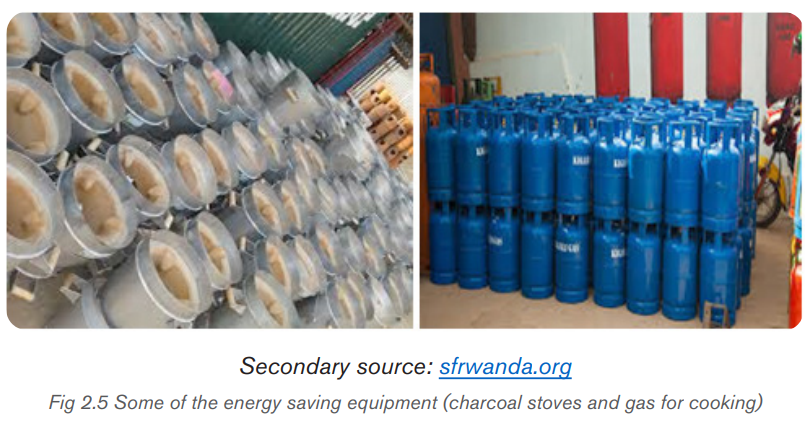
Let us say that you have an industrial Laundromat. You should pick detergents that
do not contain harsh chemicals that will be toxic to the environment.
On the other hand, if you have a restaurant, use compostable take-out trays.
For those who offer janitorial services, use eco-friendly cleaning products.
• Training Employees: It is not enough that you have green equipment and supplies.
To truly become an advocate of environmental sustainability,
your workforce has to take part. That being said, companies should
also invest in educating their employees about what they can do to
be a part of the revolution. They should exert proactive efforts.
Collectively, this can do a lot for the betterment of the environment.
• Practicing Recycling: This is one of the most popular ways to show
your environmental concern. Aside from being good for the environment,
recycling can offer a number of business benefits, such as lowering costs
associated with disposal of waste, improving company image,
minimizing the need to purchase new supplies, and encouragingcreativity through thinking of ways to re-use things that would have been thrown away.
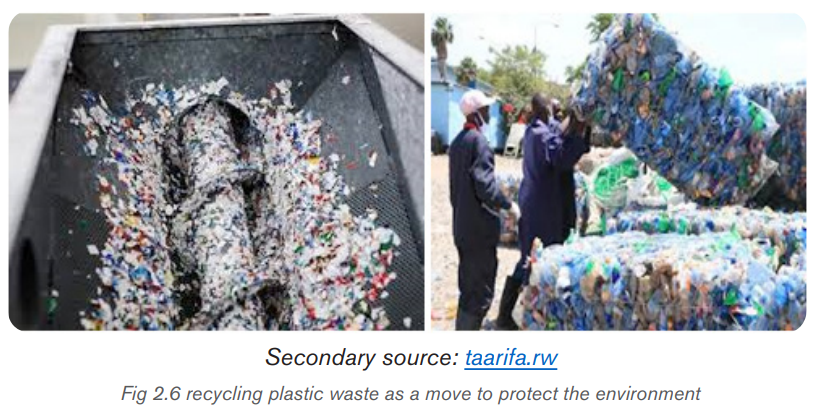
Improve energy efficiency: By minimizing the energy consumption
of your business, you are reducing your carbon footprint and doing
something good for the environment. One thing to consider is the use
of solar panels to harness an alternative source of energy to provide
the electricity needed by the business. Choose appliances with Energy
Star Certification. The implementation of the right energy strategieswill help achieve significant business growth.
• Harness technology: There are also many ways
to take advantage of technology to reduce the environmental
impact of your business. For instance, use teleconferencing
to meet with your potential clients rather than driving or flying.
Technology can also improve the efficiency of business processes,making it possible to reduce wastage of resources.
• Reforestation programs
• Sensitization and education of the general public
about the importance of conserving the environment
• Soil conservation and management• Following environment laws set by the government
By practicing the tips that have been mentioned above,
it will be easier for a business to demonstrate its concern
for the environment. In turn, this will be instrumental
in creating a positive brand image, and hence, will help the businessto achieve profitability while being eco-friendly.
Application activity 2.2
As a student of entrepreneurship suggest possible outcomes
that would result from businesses operating in Rwanda withoutan environmental impact assessment report.
2.3 Meaning of EIA report and steps of preparing an EIA report
Activity 2.3
Case Study:
While entrepreneurs are undertaking economic activities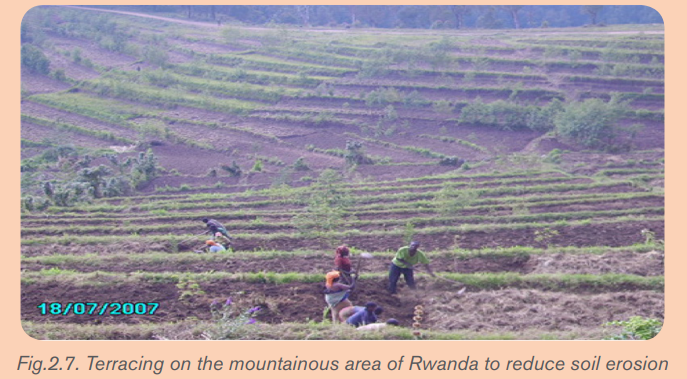
or setting projects, they have to be cautious to reduce adverse effects
on the environment and human beings. This can be done by replacing
and/or modifying planned activities to reduce negative impacts.
For example in the above picture where terraces are used to reduce soil
erosion and other environmental effects resulting from agricultural
activities therefore it is a mandate for all business people intending
to start projects to write an environmental impact assessment report
showing how the project will address the above negative effects whileaccumulating sales and profits.
Questions:
a. According to your own understanding, what do you think
is an environmental impact assessment report?
b. Suggest the steps you think should be involvedin preparation of environmental impact assessment report.
2.3.1 Meaning of EIA report
An environmental impact assessment report is a detailed
document involving a systematic process for identifying,
predicting and evaluating the environmental effects of proposed
actions and projects. This process is applied prior to major decisions
and commitments with particular attention given to preventing,
mitigating and offsetting the significant adverse effects of proposed undertakings.Historical background & Context of EIA in Rwanda
Environmental challenges in Rwanda date back several decades.
Recently, the government of Rwanda has undertaken strong
commitment to understand its current and future environmental
challenges as a necessary step in the pursuit for sustainable development.
Today, to effectively manage environmental challenges.
EIA was adopted to effectively manage environmental challenges such as:
• Soil erosion.
• Deforestation.
• Wetland drainage.
• Water degradation.• Climate change and the loss of biodiversity.
The national environmental challenges are exacerbated
/intensifiedby the:
• Low levels of environmental awareness.
• Inadequate technical & human resources.
• Low intra-sectorial coordination on environmental issues.
Thus, these EIA guidelines should serve as a protocol
for use by various stakeholders involved in the conductof environmental impact assessment.
National Policy on EIA
The Constitution of the Republic of Rwanda adopted in June 2003
ensures the protection and sustainable management of environment
and encourages rational use of natural resources.
Various initiatives were taken by the Government of Rwanda (GoR)
to address the environmental issues; these include:
• Formulation of environmental policy (2003);
• Enactment of environmental Organic Law No. 04/2005 of 08/04/200 (2005);
• Establishment of Rwanda Environmental Management Authority (REMA),
under Organic Law No.04/2005 of 08/04/2005 Article 64, to coordinate
and oversee all aspects of environmental management for sustainable development.
• Other various socio-economic development policies and strategies such as
“Rwanda Investment and Exports Strategic Action Plan, 2005-2007”.
Vision 2020” calls for a well-regulated environment management system
that takes into account principles of sustainable development whileat the same time contributing to poverty reduction.
Note: EIA is an invaluable tool for environmental management
in a trans-boundary context, playing role in information dissemination
between Rwanda and neighboring countries and widening
the scope of understanding of environmental impacts beyond its borders.
EIA process in Rwanda provides a pretext and basis for future
international cooperation and conflict resolution concerningenvironmental impacts at a regional level.
Objectives, Roles and Benefits of EIA in Rwanda
The main objective of EIA is to promote sustainable
development and ensure that environmental issues are given proper priority.
This is in line with that is fully committed in its pursuit for sustainable development
with the objectives of enhancing living standards of people in a short period
of time and obtaining true benefits to sustainably balance human needs
with nature for today’s and future generations.The objectives of EIA are four-fold:
• To provide a national standardized process for development authorization.
• To protect Rwanda’s natural environment from potentially
significant and avoidable impacts caused by development projects.
• To invoke environmental consciousness and responsibility
for all development activities in Rwanda.
• To facilitate efficient and modern development activitieswhilst considering the needs of present and future generations.
a. Project brief submission and registration: As a first step2.3.2 Steps of preparing an EIA report
EIA in Rwanda consists of the following procedures:
in the EIA process, a developer proposing to start a project shall
notify REMA in writing by submission of a Project Brief.
The purpose of a project brief, which is to provide information
on the proposed activity so as to enable REMA and Lead Agencies
establish whether or not the activity is likely to have significantimpact on the environment, and thus determine the level of EIA necessary.
b. Scoping and consideration of alternatives: The responsibility
for scoping is done by developers (or their EIA experts)
in consultation with Lead Agencies and all relevant stakeholders.
Scoping is intended to establish important issues to be addressed
in the environmental impact and eliminate the irrelevant ones.
After scoping, REMA approves the terms of reference that would be usedfor carrying out the environmental impact study.
c. Baseline data collection and analysis of initial state: Baseline data
describes status of existing environment at a location before intervention
of the proposed project. Site-specific primary data on and around
a proposed site should be collected by experts conductingthe environmental impact study to form a basis for future environmental monitoring.
d. Impact prediction and analysis of alternatives: Impact prediction
is a way of forecasting the environmental consequences of a project and its alternatives.
This action is principally a responsibility of an EIA expert.
For every project, possible alternatives should be identified
and environmental attributes compared. Alternatives should
cover both project location and process technologies.
Alternatives should then be ranked for selection of the most
optimum environmental and socio-economic benefits to the community.
Once alternatives have been analyzed, a mitigation plan should be drawn up
for the selected option and is supplemented with an Environmental Management Plan (EMP)to guide the developer in environmental conservation.
e. Public hearing: After completion of EIA report, the public must be informed
and consulted on a proposed development. REMA may, if it deems necessary,
conduct a public hearing before EIA reports are appraised by its technical committee.
Any stakeholders likely to be affected by the proposed project are entitled to have access
to unclassified sections of the EIA report and make oral or written comments to REMA.REMA shall consider public views when deciding whether or not to approve a proposed project.
f. Decision-making: During the decision-making and authorization phase,
EIA documents submitted to the Authority are reviewed
by two decision-making committees: a technical committee
and an executive committee constituted by REMA.
If the project is approved, the developer will be issued
with an EIA certificate of authorization, which permits implementation
of the project in accordance with the mitigation measures in the EIAreport and any additional approval conditions.
g. Environmental monitoring: Monitoring should be done during
both construction and operation phases of a project.
It is done not just to ensure that approval conditions are complied
with but also to observe whether the predictions made in the EIA
reports are correct or not. During implementation and operation of a project,monitoring is a responsibility of the developer and REMA.
Application activity 2.3
For EIA certificate to be finally obtained from the authorities
(REMA offices of a given district), there is a process that developers have to go through.
Given your knowledge and background about EIA so far,what process should one go through while preparing the EIA report?
2.4 Importance of EIA report
Activity 2.4
Kayitesi is a S6 leaver who has just started to operate a mining business
activity in Bugesera district. She has not been able to prepare any document
related to how the activity will have an effect to the environment both
positively and negatively, the district officials having obtained informationabout her illegal activity.
She has been summoned/called by the district office to give clear
explanation to her activities in case she suffers punishment from REMA.Questions;
1. As a student of entrepreneurship whom Kayitesi has approached for advice.
Advise her by identifying the importance of preparing an environmental
impact assessment report
2. What are the likely consequences of not submitting the EIA report to REMA
before starting any business activity?
Importance of the environmental impact assessment
report includes the following:
• It is a key component of a more systematic and objective
approach to environmental issues.
• Provides a framework for promotion of efficient
decision-making in project approval.
• Enables implementation of environmental safeguards to mitigate
significant negative impacts.
• Avoid ecological damage and large-scale irreversible
loss of natural resource.
• An invaluable tool for environmental management
in a trans-boundary context.
• Provides a basis for future international cooperation
and conflict resolution concerning environmental impacts
at a regional level.
• Enables incorporation of environmental considerations
in design and site selection for a project or development activities.
• Providing information beneficial to decision making.
• Enhancing responsibilities of relevant parties in the development process.
• It helps in mitigating and minimizing environmental damage.
• Helps to void costs and delays in implementation of projects
that would arise from unanticipated environmental problems.
• Makes developmental projects more financially and economically efficient.
• Provides active contribution towards sustainable development in the country as a whole.
Application activity 2.4
What is essential in an EIA? (Select all that apply):
a. That it allows decision makers to assess a project’s impacts
in all its phases.
b. That it allows the public and other stakeholders to present
their views and inputs on the planned development.
c. That it contributes to and improve the project design,so that environmental as well as socioeconomic measures are core parts of it.
Skills Lab -2-
1. The government is running a youth empowerment program
aiming at making youths start strong, viable and sustainable projects
in their communities. One of the conditions is that for the youth
to qualify for the program is to develop EIA report of the project
that will be supported. Using the above information (about EIA report),
write a simple EIA report for the project you would present to the governmentto win the above support.
2. Design an EIA report for the business club activities
End of unit assessment
Mahoro a TTC graduate in the recent world vision competitions
for entrepreneurship presented a business to start a tea processing
project extracted from avocado seed and won 5 million Rwandan francs.
Mahoro has approached you as a friend to seek for advice before
going ahead with her project. So, she presents to you the following questions:
a. Identify the positive and negative impacts such a project
may have on the surroundings/environment.
b. Suggest the possible strategies that Mahoro can apply to reduce
the negative effects of the above project on the environment.
c. What major steps will Mahoro have to include in the environmental
impact assessment report to be submitted to REMA. d.Explain the importance of such a report to the general development of the business.
